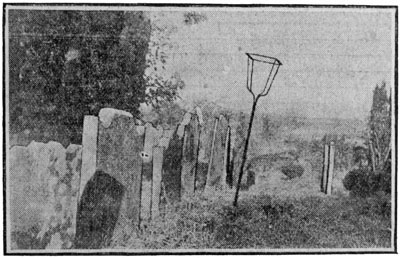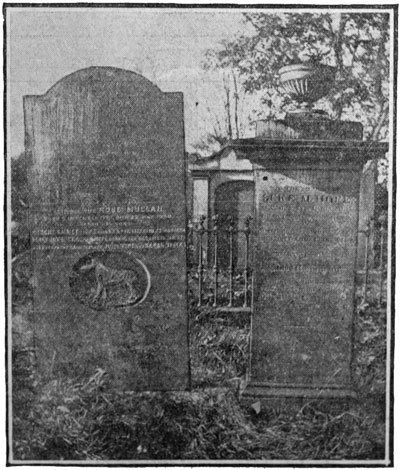Belfast Evening Telegraph, Tuesday, December 18, 1906
VII -- Mallusk Burying-Ground
It is a hazy October morning as we bowl along the Antrim Road. The lough and its surroundings are enveloped in a ghostly mist, and the details of the scene merge into each other and form a cold, impressionistic picture. There are not many afoot, as the conditions are uninviting. Presently at Glengormley we take a sharp turn to the left, and enter unfamiliar ground. We dash through a small primitive village known as High town, a village which sent many a well-meaning son into the middle of the troubles which marked the close of the eighteenth century. It is a small collection of white houses, and we are scarcely through the village before we turn sharply to the right to enter a long undulating highway running parallel with the Antrim Road. There is on every side a suggestion of prosperity -- Large, well-kept farms, with well-stocked barns on either hand, in the middle of an ocean of fields carefully cleared of their fruits, proclaimed that industry and care (without which the prosperity would be missing) abounded.
Then in the middle of all these signs of life we find on our right a little enclosure, in the forefront of which a number of modern memorials stand out with a vivid distinctness against a background of bright green. This is Mallusk burying-ground.
A short lane brings us to the entrance, and there we find that the graveyard is under the jurisdiction of the Belfast Union, who on a large board of the usual black-and-white type, set forth the graduated scale of fees which they charge, from the 2s 6d for labourers and poor persons to the £2 for those residing outside the Belfast rural district. Adjacent to this is a notion which, but for its up-to-date appearance, might have been left over from the Middle Ages. Here it is:--
NOTICE
NO PERSON OTHER THAN
THE APPOINTED GRAVE-DIGGER
IS PERMITTED TO DIG GRAVES
IN THIS GRAVEYEARD
BY ORDER
The Burial Board.
This set the thinking apparatus working to endeavour if possible to discover what particular offence had been committed that necessitated the framing of such a notice. Where the people of the district in the habit of digging graves indiscriminately, or had they a disinclination to pay the modest fees demanded and so helped themselves to a grave when required? I couldn't make it out, so I entered the rude iron gate, and stood within the old part of the ground.
Although the new monuments seem to rear their heads disdainfully above their humbler brethren of an earlier age, the ancient stones attract attention by the dignity of their proportions and the modesty of their claims. There are some notable people buried here.
In the centre of the ancients have it all to themselves. Here we are in a bygone age. There is a thin iron standard with a lamp frame -- a famous relic of the body-snatching days. They had no watch-house here, and so the relatives of the recently-interred lighted the lamp and sat by the graveside every night for the usual period.

View of the ancient portion of Mallusk Cemetery, showing the old lamp standard
A yard or two away there is an old font sunk into the ground, leaving nothing but the top surface and the basin visible. There is such a number of peculiar inscriptions that it is difficult to make a selection. I take the first at hand:--
Here lieth the Body of
Joseph Thoburn who died
March 21st 1758, aged 67 yrs.
also his wife Agnes, died
Feb. 8 1766, aged 78 yrs.
also David Thoburn of
Belfast departed this life
Aged 72
Nov. 1st 1798, also Margaret
Augt. 5th 1785.
his wife, aged 63, who died
The sculptor had actually omitted the age, which was added afterwards. A very venerable quartette indeed! The next is --
HERE LIES
The body of James Boyd of Be
lnabernice parish of Templepatr-
ick who departed this life
the 8th February 1804 aged 59
years. Also Janet Boyd his
daughter who died young.
Though hop'st to-morrow's sun to see
And let the busy world go by
Now reader pause attend to me
Alas last evening so did I.
This poetical warning is continued, and it is impossible to refrain from admiring the confidential tone generally adopted by those who framed these gems, which were fashionable a hundred years ago. In this case the sculptor was rather prodigal with his space, so that when the next person came to be buried there his inscription had to be engraved on the back of the tombstone. There is an ambiguity about the lines devoted to "John McNifh, who died August 11th 1784, aged 36 years" --
To see the sick he took great care
And to the poor he did not spare
A pious lie in him did shine
Above some Thousands in his time.
The author of this quatrain deserved a place with Browning if only for his delightful way of puzzling his readers. The new stones form a very striking contrast, but away hidden beneath the shadows of the hedge which surrounds the ground is a modest memorial that speaks more eloquently than the most elaborated arrangement conceivable. It is a roughly-constructed wooden cross -- not very large -- with the inscription roughly cut and erected by a father in memory of his son. It was a strangely touching sight! But we must on! Here is something with a flavour of exciting times --
ERECTED
to
the memory of
James Biggar, High town
who departed this life August
18th 1838 aged 87 years.
For many years he was an Irish
Volunteer and Rendered good service
to the cause of Freedom. He fought
at Antrim on the 7th June 1798 and at
all times upheld the honour of his
native land.
For dearer the grave or the prison
Illumed by one patriot name
That the trophies of all, who have risen
On Liberty's Ruin, to Fame.
Those who know their -- "'98" -- will remember Biggar. And a few yards away is a stone to the memory of one of this colleagues, "honest Jemmy," as he was called. James Hope, one of the foremost of the United Irishmen -- practically one of the originators -- a man about whom (apart from his politics) not even his greatest enemy could say one word to his discredit. He was a bosom friend of Neilson, and McCracken, and Russell, and Emmet, and took a prominent part in the negotiations which led up to the Battle of Antrim. Perhaps some of our readers could explain the meaning of the roughly-carved dog figure on his tombstone. Here is the inscription:--
SACRED
to the memory of
James Hope
who was born 1764 and died 1847.
One of Nature's Noblest Works
An Honest Man
Steadfast in faith and always hopeful
In the Divine Protection
In the Best Era of his country's history
A Soldier in her cause
and in the worst of times still faithful to it
Ever True to Himself and to those
who trusted to him he remained to the last
unchanged and unchangeable
in his fidelity.
Then there are the added the names of his wife and sons and his father and mother, while in the next plot there is a more ambitious monument

Memorials of James Hope, one of the leaders of '98, and his son Luke M. Hope, editor of the "Rushlight."
To the memory of
Luke M. Hope
(Editor of The Rushlight).
He is described in Young's Town Book as a son of James Hope. The inscription continues --
whose life was distinguished
by
The superiority of his talents
The purity of his principles
and
The simplicity of his manners.
This monument
is placed by a few of the many friends
who valued his worth
and regret his premature death.
The tear that we shed though in secret it rolls
Shall long keep his memory green in our souls.
As I left the quaint little cemetery I could not help thinking that many who read these lines will be surprised to know that there is such an interesting collection at our very gates.

